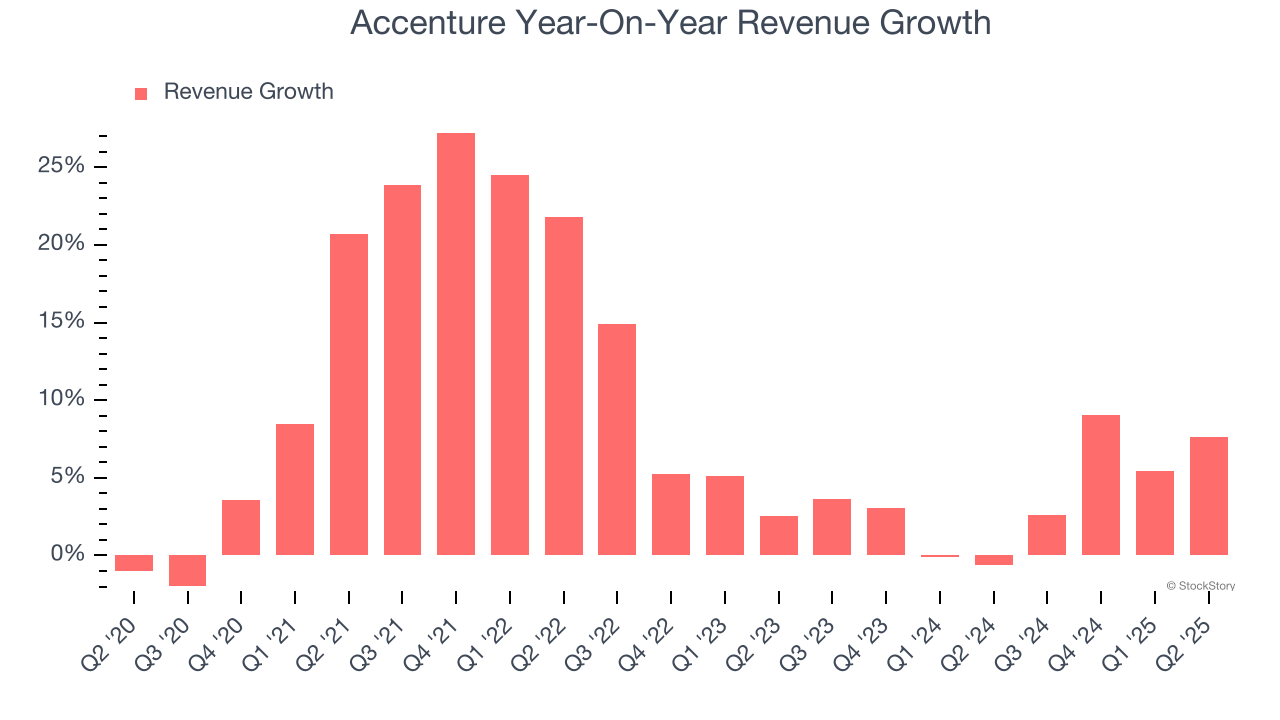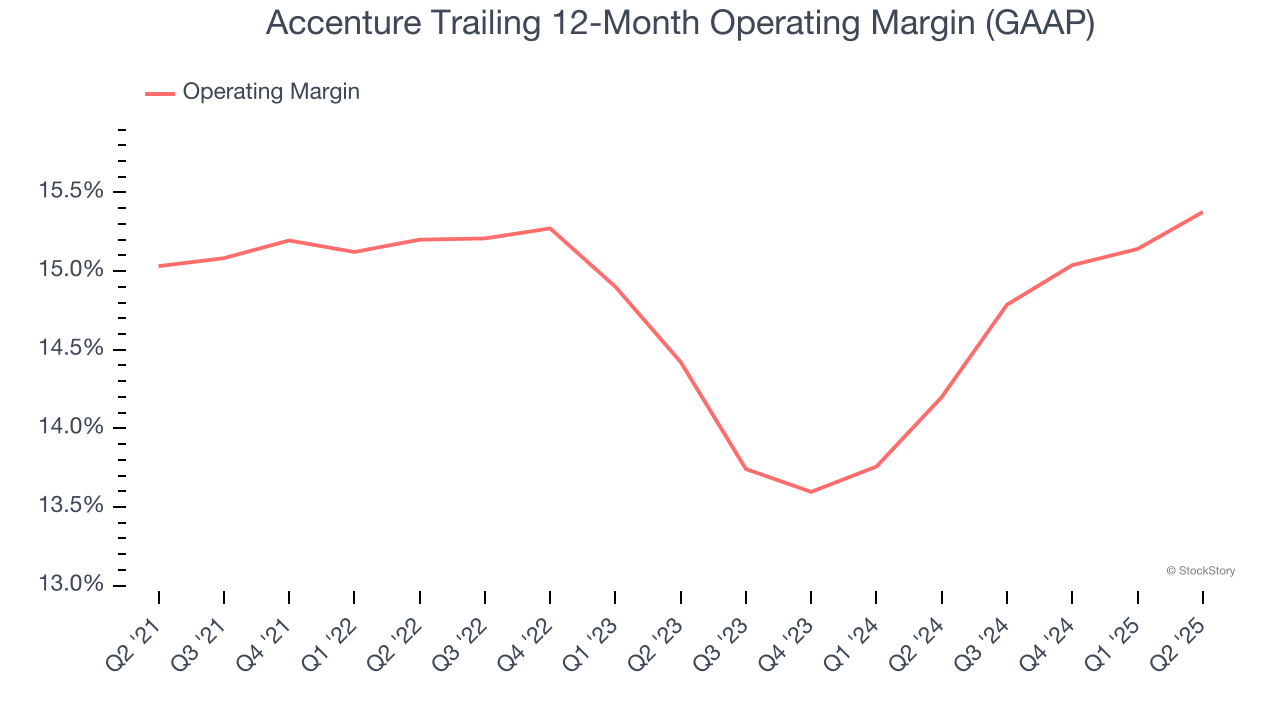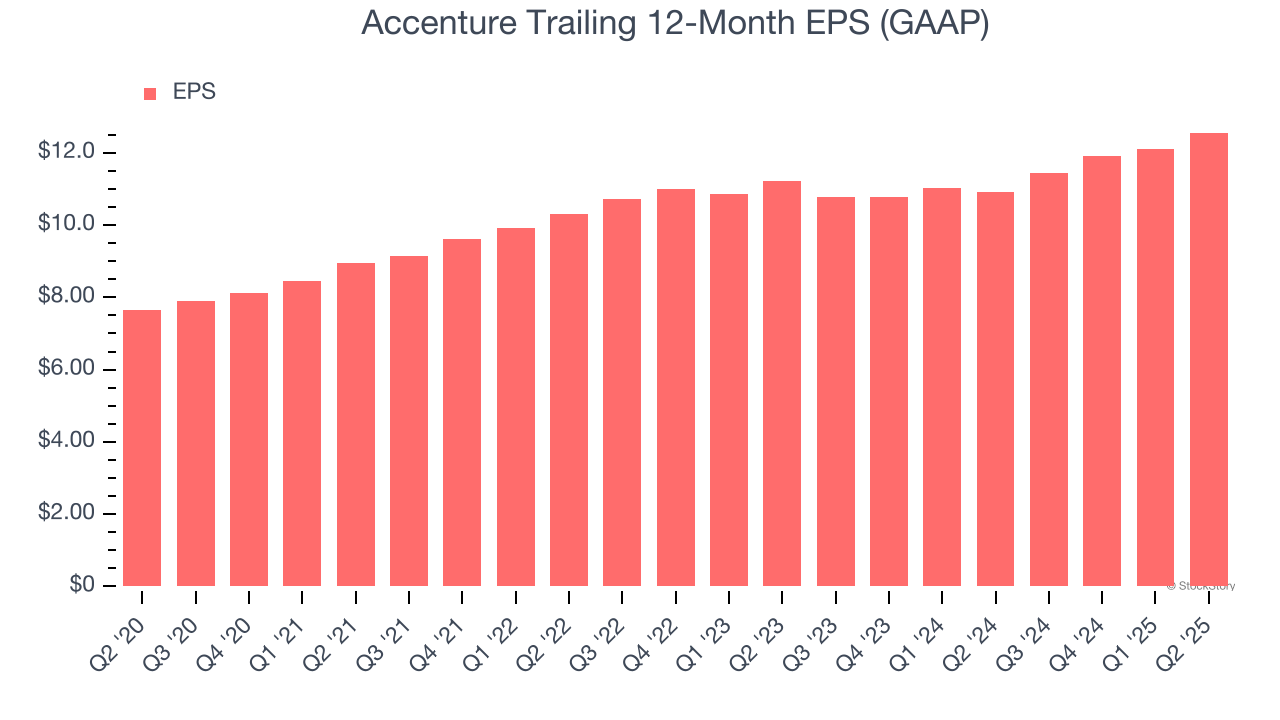
Global professional services company Accenture (NYSE: ACN) reported Q2 CY2025 results exceeding the market’s revenue expectations, with sales up 7.7% year on year to $17.73 billion. Guidance for next quarter’s revenue was better than expected at $17.3 billion at the midpoint, 1.3% above analysts’ estimates. Its GAAP profit of $3.49 per share was 5.2% above analysts’ consensus estimates.
Is now the time to buy Accenture? Find out by accessing our full research report, it’s free.
Accenture (ACN) Q2 CY2025 Highlights:
- Revenue: $17.73 billion vs analyst estimates of $17.33 billion (7.7% year-on-year growth, 2.3% beat)
- Bookings: $19.7 billion vs analyst estimates of $21.5 billion (6% year-on-year decline, 8.4% miss)
- EPS (GAAP): $3.49 vs analyst estimates of $3.32 (5.2% beat)
- Revenue Guidance for Q3 CY2025 is $17.3 billion at the midpoint, above analyst estimates of $17.08 billion
- EPS (GAAP) guidance for the full year is $12.83 at the midpoint, roughly in line with what analysts were expecting
- Operating Margin: 16.8%, in line with the same quarter last year
- Free Cash Flow Margin: 19.8%, up from 18.3% in the same quarter last year
- Market Capitalization: $191.8 billion
Company Overview
With a workforce of approximately 774,000 people serving clients in more than 120 countries, Accenture (NYSE: ACN) is a professional services firm that helps organizations transform their businesses through consulting, technology, operations, and digital services.
Revenue Growth
A company’s long-term sales performance is one signal of its overall quality. Even a bad business can shine for one or two quarters, but a top-tier one grows for years.
With $68.48 billion in revenue over the past 12 months, Accenture is a behemoth in the business services sector and benefits from economies of scale, giving it an edge in distribution. This also enables it to gain more leverage on its fixed costs than smaller competitors and the flexibility to offer lower prices.
As you can see below, Accenture’s 9% annualized revenue growth over the last five years was solid. This shows it had high demand, a useful starting point for our analysis.

Long-term growth is the most important, but within business services, a half-decade historical view may miss new innovations or demand cycles. Accenture’s recent performance shows its demand has slowed as its annualized revenue growth of 3.8% over the last two years was below its five-year trend. 
This quarter, Accenture reported year-on-year revenue growth of 7.7%, and its $17.73 billion of revenue exceeded Wall Street’s estimates by 2.3%. Company management is currently guiding for a 5.5% year-on-year increase in sales next quarter.
Looking further ahead, sell-side analysts expect revenue to grow 4.1% over the next 12 months, similar to its two-year rate. This projection is underwhelming and implies its newer products and services will not catalyze better top-line performance yet.
Software is eating the world and there is virtually no industry left that has been untouched by it. That drives increasing demand for tools helping software developers do their jobs, whether it be monitoring critical cloud infrastructure, integrating audio and video functionality, or ensuring smooth content streaming. Click here to access a free report on our 3 favorite stocks to play this generational megatrend.
Operating Margin
Operating margin is an important measure of profitability as it shows the portion of revenue left after accounting for all core expenses – everything from the cost of goods sold to advertising and wages. It’s also useful for comparing profitability across companies with different levels of debt and tax rates because it excludes interest and taxes.
Accenture’s operating margin has been trending up over the last 12 months and averaged 14.8% over the last five years. On top of that, its profitability was top-notch for a business services business, showing it’s an well-run company with an efficient cost structure.
Analyzing the trend in its profitability, Accenture’s operating margin might fluctuated slightly but has generally stayed the same over the last five years. This raises questions about the company’s expense base because its revenue growth should have given it leverage on its fixed costs, resulting in better economies of scale and profitability.

This quarter, Accenture generated an operating margin profit margin of 16.8%, in line with the same quarter last year. This indicates the company’s overall cost structure has been relatively stable.
Earnings Per Share
Revenue trends explain a company’s historical growth, but the long-term change in earnings per share (EPS) points to the profitability of that growth – for example, a company could inflate its sales through excessive spending on advertising and promotions.
Accenture’s solid 10.5% annual EPS growth over the last five years aligns with its revenue performance. This tells us it maintained its per-share profitability as it expanded.

In Q2, Accenture reported EPS at $3.49, up from $3.04 in the same quarter last year. This print beat analysts’ estimates by 5.2%. Over the next 12 months, Wall Street expects Accenture’s full-year EPS of $12.56 to grow 5.8%.
Key Takeaways from Accenture’s Q2 Results
It was good to see Accenture’s revenue beat expectations. Revenue guidance for next quarter also topped Wall Street's estimates. On the other hand, bookings in the quarter (a leading indicator of revenue) missed and EPS guidance was just in line. Overall, we think this was a mixed quarter, and the market seemed to be hoping for more. The stock traded down 3.5% to $295.64 immediately after reporting.
Is Accenture an attractive investment opportunity right now? The latest quarter does matter, but not nearly as much as longer-term fundamentals and valuation, when deciding if the stock is a buy. We cover that in our actionable full research report which you can read here, it’s free.






